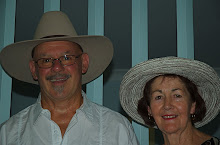The final major tourist attraction we wanted to experience was the West Coast Wilderness Railway. This railway was originally used by Mt Lyell Mining to haul the output from the Queenstown mine but was pensioned off in 1963. With the aid of Bi-Centenary Funding the railway was bought back to life as a tourist attraction and is very popular to this day.
The carriages and the Strahan railway station of the West Coast Wilderness Railway.
This was to be our locomotive for the initial section of the trip to Queenstown. This diesel locomotive is used for the less steep sections of the rail line.
As we leave Strahan we follow the King River. You might notice by the colour of the water and the sterile river banks that it is polluted with the effluent from the Mt Lyell Copper Mine.
At one of our stops along the way we discovered this old wooden bridge in the forest.
This is one of the many steel trestle bridges that we cross on our journey.
Jude is listening for the whistle of the next train to come along.
The pollution of the water and the silt from the tailings is quite evident in this shot.
The forestry and local schools have been busy planting grasses and trees along the river in an attempt to revegetate the river banks.
This photo shows the Queen River. The Queen flows from Queenstown and joins the King River. The Queen River shows the effects of the mine pollution far more than the King River. You can just make out the relic of an old timber structure destroyed by floods many years ago.
Looking upstream crossing the Queen River, here you will see the remans of an old steel bridge destroyed by the same floods.
Track workers waiting for the train to pass.
At the half way point is "Dubbil Barril Station", here, while the passengers enjoy the lunch break, the diesel locomotive is replaced with the steam locomotive. Here the steam locomotive is moving onto the turntable to be readied for it's return journey to Queenstown.
A peek in side the driver's compartment.
The turntable is hand propelled by the driver and the fireman.
The funnel and whistle are polished copper.
The steam locomotive shunting the carriages to the platform for us to board. The steam locomotive uses the 'ABT' traction system. The ABT system is a pinion drive under the engine that engages a rack fastened onto the railway sleepers. Here you can clearly see the rack positioned between the two rails.
It is not really clear here but there are two pinion gears under the engine that engage with the rack. These pinion gears are driven independently of the wheels and the push rods can be seen behind the wheels.
Another glimpse of the greatly polluted Queen River.
As we view the Queen River once more we are climbing an incline at a ratio of 1 in 20. Without the ABT system this would be impossible.
We had one final stop to have a quick look at this abandoned mine.
And this is the name of the mine. From here onto Queenstown we are travelling downhill at the ratio of 1 in 16.






















No comments:
Post a Comment